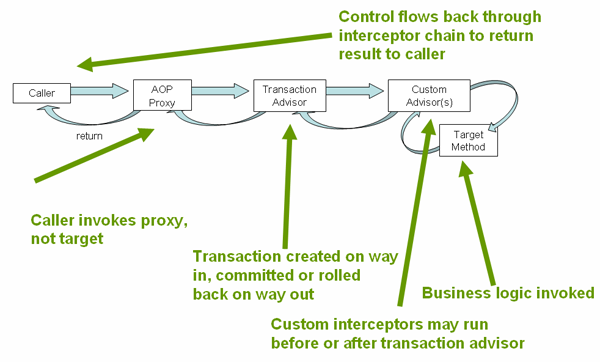|
This version is still in development and is not considered stable yet. For the latest stable version, please use Spring Framework 6.2.11! |
Understanding the Spring Framework’s Declarative Transaction Implementation
It is not sufficient merely to tell you to annotate your classes with the
@Transactional annotation, add @EnableTransactionManagement to your configuration,
and expect you to understand how it all works. To provide a deeper understanding, this
section explains the inner workings of the Spring Framework’s declarative transaction
infrastructure in the context of transaction-related issues.
The most important concepts to grasp with regard to the Spring Framework’s declarative
transaction support are that this support is enabled
via AOP proxies and that the transactional
advice is driven by metadata (currently XML- or annotation-based). The combination of AOP
with transactional metadata yields an AOP proxy that uses a TransactionInterceptor in
conjunction with an appropriate TransactionManager implementation to drive transactions
around method invocations.
| Spring AOP is covered in the AOP section. |
Spring Framework’s TransactionInterceptor provides transaction management for
imperative and reactive programming models. The interceptor detects the desired flavor of
transaction management by inspecting the method return type. Methods returning a reactive
type such as Publisher or Kotlin Flow (or a subtype of those) qualify for reactive
transaction management. All other return types including void use the code path for
imperative transaction management.
Transaction management flavors impact which transaction manager is required. Imperative
transactions require a PlatformTransactionManager, while reactive transactions use
ReactiveTransactionManager implementations.
|
A reactive transaction managed by When configured with a |
The following image shows a conceptual view of calling a method on a transactional proxy:


